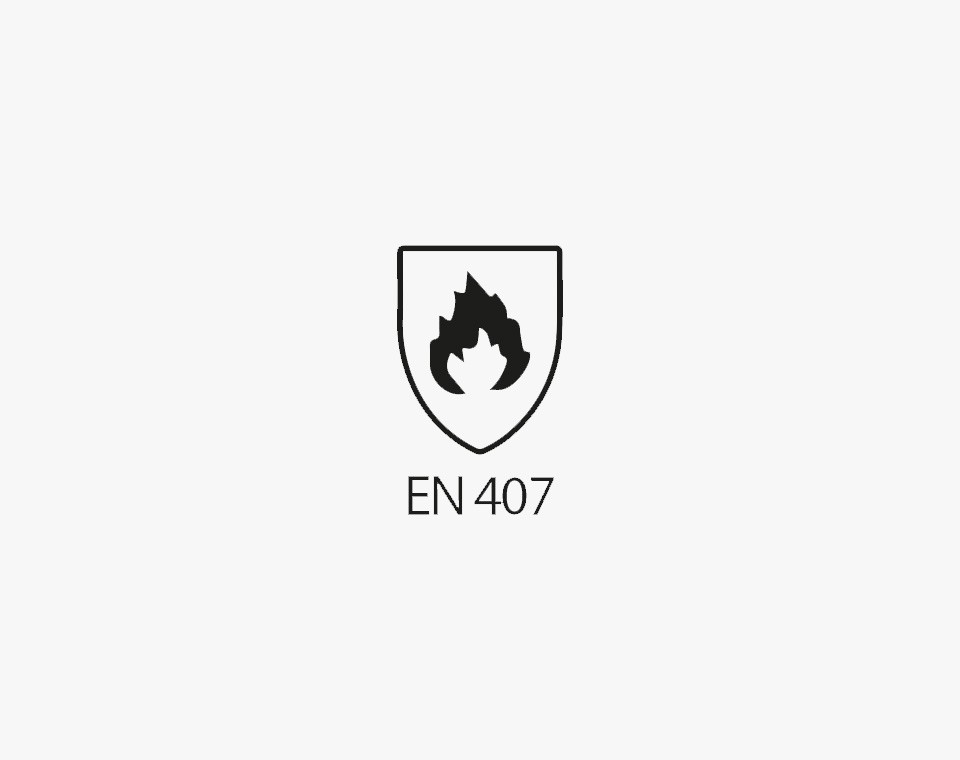PPE - Glove
Hand protection against various thermal risks

EN 407 specifies the requirements, test methods, marking and information for protective gloves and other hand protection equipment against thermal risks for professional, consumer and domestic use. This document also applies to arm protection equipment. It covers all gloves and other hand protection equipment that protect the hand or part of the hand against heat and/or fire in one or more of the following forms: flame, contact heat, convective heat, radiant heat and small or large splashes of molten metal.

The performance of gloves complying with the EN 388 standard is given by different indices:
A: Flame resistance – 1 to 4
Flame resistance is determined by the duration of flame persistence on the glove or mitten, i.e. the time it takes for a glove or mitten to stop burning, to burn out. During the test, the sample is exposed to an open flame for 15 seconds. The shorter the flame duration, the higher the flame resistance of the glove. In the event of possible contact with an open flame, a high level glove with a short flame persistence time should therefore be preferred.
Performance level: Flame resistance (duration in seconds of flame persistence)
Level 4 ≤ 2 seconds
Level 3 ≤ 3 seconds
Level 2 ≤ 10 seconds
Level 1 ≤ 20 seconds
B: Resistance to contact heat – 1 to 4
Contact heat resistance is determined by the temperature at which heat transfer takes place, resulting in an increase in temperature inside the glove or mitten. During the test, the sample is exposed to heat sources of different temperatures (between 100°C and 500°C). To validate a performance level, the sample must resist the corresponding contact heat, i.e. maintain a stable internal temperature during the first 15 seconds of exposure.
Performance level: Contact heat resistance (Temperature at which painless heat transfer occurs over a period of at least 15 seconds).
Level 4: 500° C
Level 3: 350° C
Level 2: 250° C
Level 1: 100° C
C: Resistance to convective heat – 1 to 4
Convective heat resistance is determined by the amount of time the outer part of the glove or mitten is protected from the heat transfer from an open flame to the inside.
Performance level: Resistance to convective heat (Critical Heat Transfer Time)
Level 4 ≥ 18 seconds
Level 3 ≥ 10 seconds
Level 2 ≥ 7 seconds
Level 1 ≥ 4 seconds
D: Resistance to radiant heat – 1 to 4
The radiant heat resistance is determined by the time required for a protective glove or mitten to reach a given maximum temperature inside the PPE. During the test, the sample is exposed to heat radiation
Performance level: Resistance to radiant heat (critical heat transfer time)
Level 4 ≥ 150 seconds
Level 3 ≥ 90 seconds
Level 2 ≥ 30 seconds
Level 1 ≥ 5 seconds
E: Resistance to minor splashes of molten metal – 1 to 4
Resistance to minor splashes of molten metal is determined by the amount of molten metal beads required to raise the temperature of a protective glove or mitten. In the test, the sample is exposed to molten metal splashes. The maximum performance level (level 4) is achieved when the amount of molten metal balls required to raise the internal temperature of the sample is greater than 35 grams.
Performance level: Resistance to minor splashes of molten metal (mass in grams required for critical heat transfer).
Level 4 ≥ 35 grams
Level 3 ≥ 25 grams
Level 2 ≥ 15 grams
Level 1 ≥ 5 grams
F: Resistance to large splashes of molten metal – 1 to 4
Resistance to large molten metal splashes is determined by the mass of molten metal splash required to damage the skin, despite wearing a thermal protective glove or mitten. In the test, a PVC skin is placed inside the sample and the PPE is exposed to molten metal splashes. The maximum performance level (level 4) is achieved when the amount of molten metal beads required to damage the skin under the PPE exceeds 200 grams.
Performance level: Resistance to large molten metal splashes (mass in grams required for critical heat transfer)
Level 4 ≥ 200 grams
Level 3 ≥ 120 grams
Level 2 ≥ 60 grams
Level 1 ≥ 30 grams
All activities in which workers are exposed to thermal risks (heat and/or fire) in one or more of the following forms: flame, contact heat, convective heat, radiant heat and small or large splashes of molten metal. Protective gloves and mittens for trades exposed to heat and/or fire: welding, glassmaking, metallurgy, bodywork, steelworks, foundry, industrial mechanics, ironmongery, steelworks, metal parts manufacturers, vulcanologists, cement works, fire service, fire brigade… etc.